A CPU is pretty hard to miss on any given computer. However, for the uninitiated and newcomers, even simple things can seem confusing, given the complexity of PC hardware.
So where is the CPU located in a computer? A CPU sits on a motherboard on a holder called a “CPU Socket.” This CPU is often the largest chip you can find on a motherboard.
However, the newcomers may also confuse the CPU with the motherboard chipset as sometimes they can have an almost similar size.
A motherboard is essentially the most prominent one you can find on a PC. It sits in the PC/laptop chassis and holds all components together.
All motherboards have a CPU socket. However, they are not all the same. Meaning specific CPU models require a particular CPU socket.
This article will discuss locating a CPU on a motherboard in detail.
TABLE OF CONTENTS
Where is the CPU Located in a Computer?
Again, the CPU is hard to miss on any computer. It is located on a large piece of equipment called the motherboard – which holds all components together.
Opening your PC case/laptop chassis to expose the motherboard and CPU would be best.
The CPU is installed on a holder called the “CPU Socket.” to locate the CPU in a computer, you must find the motherboard’s CPU socket.
The exact location of the CPU socket on a motherboard may vary a bit depending on the form factor. However, it can often be found next to the RAM slots.
On an entire ATX motherboard, as shown above, and on the micro ATX motherboard, the location of the CPU is often at the top center.
On a mini ITX motherboard, the CPU socket is almost at the motherboard’s dead center.
The following image shows what a CPU socket on a motherboard looks like WITHOUT a CPU installed.
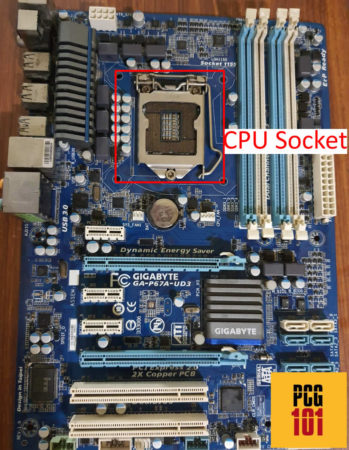
In most cases, you can plug the CPU in and out of the socket using the mechanism provided on the motherboard.
Also Read: How to Check Motherboard Socket?
You Install the CPU in the Socket:
A CPU is installed on a motherboard using the mechanism provided on the socket itself. The mechanism involves pulling a lever.
The image below shows how the lever works:
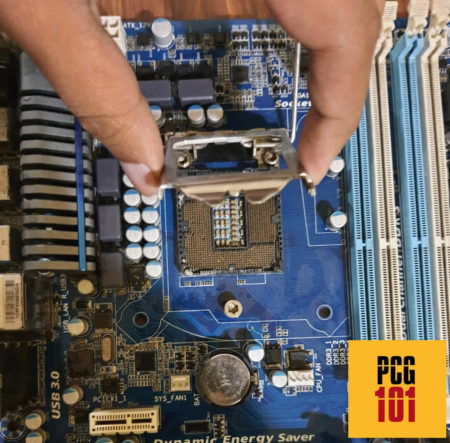
On an Intel motherboard, as shown above, the lever is lifted first; this opens up the CPU socket lock for CPU installation.
Once the socket opens up, the CPU is then placed carefully on the pins of the socket and then locked back again, as shown below:

Also Read: How Many Pins Does a CPU Have?
A Cooling Fan conceals the CPU!
When you open up your case for the first, it may be hard to detect the CPU because a cooling fan almost always covers them.
If that is the case, then before asking where the CPU is located in a computer, you must remove the cooling fan first.

A cooling fan is installed on a CPU because it generates a lot of heat. If adequate cooling is not provided, you may notice the first issue lags in performance and frame rate drops in gaming.
Your system will keep shutting down once the CPU reaches its TJmax temperature. In worst cases, the CPU can get damaged if cooling is not provided.
Also Read: How to Tell if CPU is Bad or Dead?
Make Sure You Do Not Confuse the CPU with the Motherboard Chipset
On desktops, sometimes you can confuse the motherboard chipset with the CPU.
This is because sometimes the CPU and the motherboard chipset can have almost the same size, confusing newbies.

There are a few ways that you can distinguish between the two.
Firstly, the motherboard chipset has no cooling fan installed on top.
Secondly, while the CPU socket is located on the top half of the board, the motherboard chipset is often found on the bottom half – often below the RAM sockets.
Finally, the motherboard chipsets have a heatsink installed on them.
Also Read:
Where is the CPU Located on a Laptop?
On a laptop, locating the CPU can become a bit more complex. There isn’t a general location for a CPU on a computer. And unlike on desktops, the CPU on laptops does not always have a square shape – it can also have a rectangular shape.
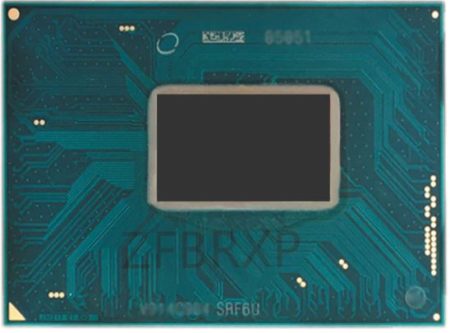
However, like desktops, a cooling fan covers a laptop’s CPU chip. Finding a fan on a chip is a good indicator that it belongs to a CPU.
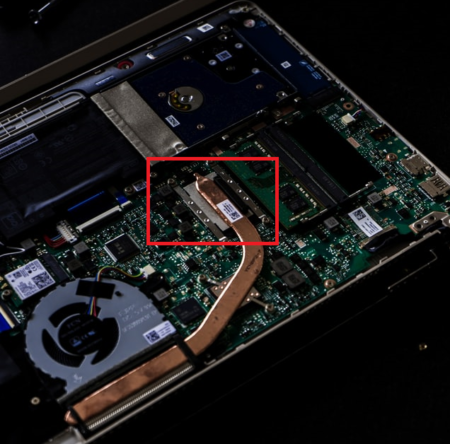
On some laptops, the CPU may be covered with copper heatsink tubes from a cooling fan, NOT directly attached to the CPU.
If you have a gaming laptop, distinguishing between the GPU and CPU chip can get confusing.
On a gaming laptop, the large heat sinks cover the top of both the CPU and GPU chips. If the CPU and GPU heatsinks are connected, you must remove the entire heatsink to expose both chips.
Also Read: Can I Upgrade My Laptop Processor from i5 to i7?
Laptops Use BGA Sockets
It is worth pointing out here that laptops do not have replaceable CPUs. Unlike sockets, laptops do not have sockets where you can plug the CPU in and out.
Instead, CPUs use Ball Grid Array or BGA sockets, whereby the CPU gets soldered directly onto the socket.
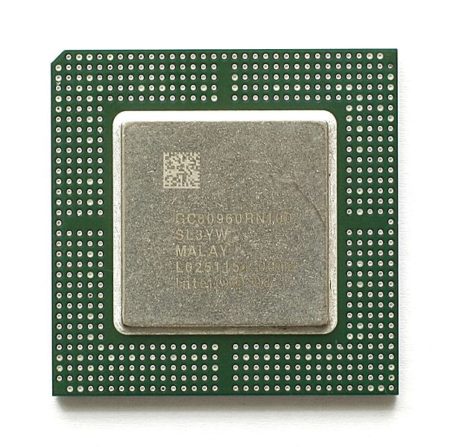
Also Read:
Motherboard Sockets are Specific to CPUs
Not all CPUs are compatible with all sockets.
CPUs have a specific requirement for which motherboard sockets they can get plugged into.
For instance, an Intel Core i7-7700K requires an LGA 1151 socket. An Intel Core i7-10700K requires an LGA 1200 socket. AMD Ryzen 1000, 2000, 3000, 4000, and 5000 desktop-based CPUs require an AM4 socket.
Therefore, before investing in a new CPU, ensure it is compatible with your current motherboard.
You can check out the socket requirements and specifications of the motherboard and the CPU by visiting their spec sheets.
Also Read:
- What CPU is Compatible with My Motherboard?
- Can You Upgrade the CPU Without Changing the Motherboard?
Final Words
Here I talked in detail about where to locate the CPU in a computer. The simple answer is that a CPU goes into a large CPU socket that is very hard to miss on a given motherboard.
On a desktop, a CPU is located in the top center, somewhere between the RAM slots and the back I/O panel of the motherboard.
FREQUENTLY ASKED QUESTIONS
1. Can you replace the CPU in a computer, or do you need to replace the entire system?
In most cases, you can replace the CPU in a computer, but it depends on the type of CPU and the motherboard.
If the new CPU is compatible with the motherboard’s socket and chipset, you can replace the old CPU with the new one.
However, if the CPU is soldered onto the motherboard, you may need to replace the entire system.
2. How can you tell if your CPU is overheating, and what can you do to prevent it?
You can tell if your CPU is overheating if your computer shuts down or becomes unstable during intensive tasks.
You can also use monitoring software to check your CPU temperature.
To prevent CPU overheating, ensure that your computer is well-ventilated and that your CPU cooler is working correctly.
You can also apply new thermal paste to the CPU to improve heat transfer.
3. How do you check the CPU usage on your computer?
To check the CPU usage on your computer, you can open the Task Manager (Ctrl + Shift + Esc) on Windows or the Activity Monitor on Mac. In both cases, you’ll see a list of running processes and their CPU usage.
You can sort the list by CPU usage to see which processes are using the most CPU.
4. Can you run multiple CPUs in a single computer, and how does that affect performance?
Yes, you can run multiple CPUs in a single computer, but it depends on the motherboard and the type of CPUs.
Some motherboards support multiple CPUs, while others only support one.
Running multiple CPUs can improve performance in applications that support parallel processing, such as video rendering and scientific simulations.
However, most applications cannot take advantage of multiple CPUs, so in some cases, the additional CPUs may not improve performance.
Also Read: Which Intel and AMD CPUs Support PCIe 4.0?
